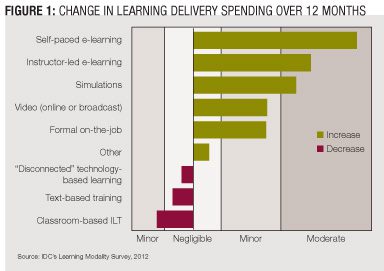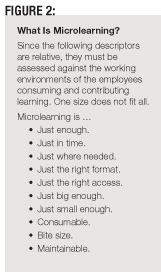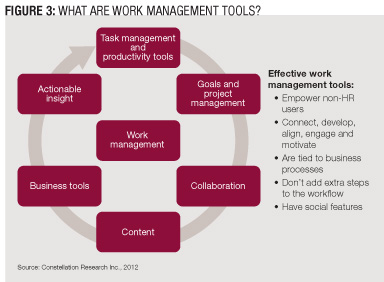When customers call a bank, they are pleased to receive perfect, courteous service. When customers bring a car in for service, they don’t want to be told the job will take two extra days because the mechanic will be in class. They want results now.
Business is about productivity, not learning. The learning challenge is to keep employees productive and learning simultaneously. Microlearning can be a critical component of the strategy because it satisfies immediate knowledge needs to enable performance. As technologies advance, microlearning evolves to match the needs and pace of business.
Learning and consumption have several similarities. According to the FDA, the most beneficial eating patterns include eating six small meals through the day when one is truly hungry as opposed to when a clock says it is time to eat. In other words, consume when needed. There is a lot to be said for applying the same strategy to learning as to nutrition. The analogies include:
• Too much consumption at one time can be painful and stressful, and the value can be lost.
• It is often wasteful. Investments of time and expense may not satisfy the true need.
• No one wants to clean up after a big meal. It can be messy and exhausting to redo learning and restore order.
Microlearning strategies facilitate knowledge acquisition, employee learning and performance support, when and where needed. It is just enough and always available should learners need to partake more as demanded. However, it is just as important to enable employees to learn where they are and to have learning be integrated tightly into their work.
Sometimes this may involve a smartphone, tablet or presentations though an online, corporate intranet. Eventually e-learning may be accessed in a manufacturing plant or hospital by scanning a QR code and reading resulting content on a handheld device. Consider current standby microlearning examples such as instant messaging, blogging and even the telephone and water cooler. These are now ubiquitous in the workplace. The expertise needed to be tapped belongs to top performers, and their knowledge transfer is not specific to a certain delivery mode.
Since micro is a relative term, let’s give it some bounds in reference to what has been common in the learning industry for years. A five-day instructor-led course would not be considered microlearning, nor would an eight-hour e-learning course. However, each lesson and its assets could be made available for easy reference when demands for performance arise. Recall that first reference to a phone call to the bank. Perhaps the bank representative is referring to information from the latest course about the new mortgage program restrictions to satisfy a customer’s call.
The learning may occur during the call to satisfy the customer and the employee aspiring to deliver excellent service.
Consider that service in a mobile environment. Now that the housing market is picking up in parts of the country, home shows and conventions are experiencing a comeback. Banks and mortgage companies may be onsite to assist with financing. They must be untethered and ready to support buyers. Perhaps they are equipped with a state-of-the-art tablet with a high-speed network connection. The same scenario can be replayed face-to-face.
Or, consider a chemical manufacturing plant that has just moved, so the location and operation for some equipment is new. Rather than expecting employees to retain everything about the facility from a class conducted a month earlier, engineers can scan a QR code using their smartphones to access documentation for the new equipment, a video of its use and directions for shutdown if necessary. Ideally, all of this would have occurred in the workers’ native language.
The learning needed for the representative and the engineers was just enough, and when and where it was needed. In both the public and private sectors, organizations have recognized the value of leveraging learning content in relevant, worker-consumed chunks.
A global engineering company might employ the strategy and realize significant savings by downsizing an expensive help desk which supports employees after the rollout of new business applications. In a large public school system, employees across the jurisdiction might access bite-sized learning assets relevant to their task at hand, enabling record keeping to be flawless in the schools and main offices.
According to Cushing Anderson of market intelligence firm IDC and his 2010 Modality Survey, “Measuring the impact of training on the enterprise is frequently weak. Most are unable to describe the business impact that successfully trained or skilled workers will have on the performance of the related technology.” This drives a trend to match more targeted microlearning investments to specific job needs.
An IDC survey also documented changes in delivery modalities into 2012. The drastic increase in asynchronous e-learning points to the workforce’s need to access what they need when they need it (Figure 1).

There are some common issues with microlearning in an organizational learning strategy.
Retention: IDC research and anecdotal data shows that knowledge retention from traditional learning methods is 20 percent at best. Perhaps the right strategy is to assume low retention and focus on leveraging all assets from the classroom as performance support. Current data and folklore indicates 70 percent of learning happens on the job.
Performance support: To match employees’ working environment, learning leaders may have to modify classroom development and think ahead to where else content will be accessed and on what device or channel.
Collaboration: As recently as 30 years ago, this looked like a tap on the shoulder, but it is powerful, and it has evolved into an electronic action. For synchronous microlearning, techniques such as instant messaging, social media and email are well understood. However, employees cannot always rely on experts’ availability, especially with the global reach of today’s organizations. Subject matter experts and mentors may be anywhere. Facilitating a platform on which it is easy to consume and contribute is a solid component of an effective microlearning strategy.
Enablement: Enabling experienced experts to articulate their knowledge and stories is easier than ever. Given available technologies, they can record their actions or their voice to enable those who need to know. A smartphone could equal a movie studio. The value of subject matter experts is not in their knowledge, but in their ability to share that knowledge and expertise, especially as they prepare for retirement or for that next job within the organization or at a new company.
Enabling those who are required to know is the next challenge in a microlearning strategy. Search, search, search should be the mantra. It does not matter how much valuable content is available for microlearning if no one can find it. Searching text contained in the content is easy. However, when the asset is a video or an online simulation of a business transaction, searching must be enabled by attaching tags and keywords relevant to the learner and in the learner’s specific context and language.
The case has been made for employee-generated content. However, just because experts have something to contribute does not mean they should. Platforms can be governed in such a way that publishing comes after composing, and learning leaders can provide all the tools and methods to make the development and review easier.
Prove it: If leaders, experts, mentors and consultants are going to invest their time to share their knowledge to be consumed in bite-size meals, it may behoove learning leaders to ensure team members consume it. Then, assess learning reception and comprehension.
The value of employee learning is measured on the job. Think about the bank representative in those two environments described. The measures of the learning to enable his or her performance could be customer satisfaction as well as new consumer loans from new and existing customers.
Imagine if learning leaders could correlate the data about the consumption of the microlearning assets to business outcomes. The business case develops itself to continue the efforts. Learning is not an industry where process compliance is externally mandated. It can be policed internally.
Does microlearning adoption mean that all learning content should be scrapped or converted? No. Innovation is demonstrated by leveraging existing assets while investing in content to satisfy the descriptors in Figure 2.

According to Yvette Cameron, vice president and principal analyst at Constellation Research Inc., managing work is the true focus in the workplace. When recently addressing an audience of human resources professionals, she highlighted the characteristics of effective work management tools (Figure 3).

She also recognized that learning is the stickiest part of the HR sphere of influence and action. The tools in Figure 3 are totally aligned with the aforementioned concepts of microlearning.
Microlearning is about employee performance support, but the label is not as important as the effect. Remember, business is all about productivity. It’s not about learning. Therefore, the tight integration of learning and business enables a culture to thrive and expect integrated learning in the workplace — just in time and just enough. Size does matter.
Malcolm Poulin is director, product strategy, for Ancile Solutions, a learning and performance software provider. He can be reached at editor@CLOmedia.com.
READER REACTION
We asked our CLO LinkedIn followers: How do you deliver bite-sized chunks of content to drive learning and productivity? How have learners responded? Here is what they had to say.
Parul Gupta: Bite-sized learning is what sticks with learners. Learners are so overloaded with content that a clear, concise and crisp bite of learning is what they cherish. I saw these bites catch fire in a leader-led development program. The small bites of learning should consist of a single topic and need to be extremely well designed.
Sameer Panuganti: I feel that microlearning in organizations has taken a center stage due to the growing pressure on people leaders to update and retain their workforce. Even though the advantages of having such learning options cannot be seen immediately, they have a lasting impact on people and the learning culture in an organization.
Jennifer Jortner Cassidy: A client of mine did a lynda.com promotion around the idea of “learning snacks” which I loved. The nice thing about our courses is that they are broken into small chunks, so while you can take an entire course, you can learn a great deal from watching a five-minute or less video — better yet while in the doctor’s office, on the train, on the treadmill, etc. I thought it was brilliant.
Spencer Buck: I am firm believer in bite-sized, just-in-time training. It’s something we help people deliver from a top-down perspective, but we also think that user-generated content (bottom up) is equally powerful to engage users. With this bi-directional approach, coupled with gamification and recognition for the user, you have a powerful platform that speaks to a millennial workforce.
Michel Koopman: In the new world of information overload, talent gaps and having to do more with less, we focus on curating the right business knowledge, expertly compressing it and making it available on-demand in a way that professionals can learn when they have 15 minutes to spare without having to “reserve” learning time; microlearning has little opportunity cost. It allows people to make better business decisions at the point of need. To be effective it does require the ability to use any device from anywhere. In this world of rapid change, learning is critical to stay relevant, but learning must be integrated into our daily responsibilities to ensure it is available and used when we need it.
Emily Connelly: We routinely break our learning modules (designed for pharmaceutical, biotech and medical device representatives) into easily digestible sections, followed by self-assessment quizzes. We find that this type of microlearning is most effective. A single course might have five, 10 or more sections that learners can complete at their own pace. Over the past few years, we’ve actually revised many of our courses so the sections are shorter, but there are more of them. We think microlearning is a positive trend with multiple applications in L&D.
David Forry: I have heard Jason Womack talk about working smarter with your time, and in his book, Your Best Just Got Better, you see how important 15 minutes can be. Our day is actually split up into 96 of these 15-minute blocks. It’s important to identify your most important things, but in my opinion it’s also very important to schedule some downtime, away from “work work.” I do this by looking at relevant news/industry sites or LinkedIn pages, but I’m also learning and bettering myself. There is absolutely time for learning in these 96 segments and they can happen in the downtime of waiting for a conference call to get going or planned as a mental escape. Afterward I feel more productive because I’m refreshed, but from a bigger picture I’m also a better-informed professional.
What do you think? Join the discussion here or join our Chief Learning Officer LinkedIn group.















